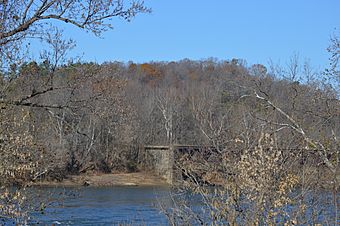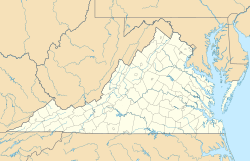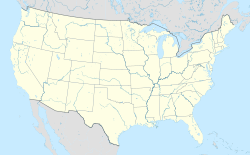Fort Riverview facts for kids
|
Fort Riverview (44AH91 and 44AH195)
|
|

Distant view from the southeast
|
|
| Nearest city | Madison Heights, Virginia |
|---|---|
| Area | 27 acres (11 ha) |
| NRHP reference No. | 89001921 |
Quick facts for kids Significant dates |
|
| Added to NRHP | November 16, 1989 |
Fort Riverview is a historic archaeological site located near Madison Heights, Virginia. It was a small but important fort built during the American Civil War. The Confederate States Army constructed this fort, also known as a redoubt, around 1863. Its main purpose was to protect vital supply lines for the Confederacy.
The fort was strategically placed to guard the Six Mile Bridge. This bridge was crucial because it carried supplies for General Robert E. Lee and his army. Fort Riverview also protected parts of the James River and Kanawha Canal system. This canal was another important way to move goods and people.
Fort Riverview was part of a larger defense system for Lynchburg, Virginia. Lynchburg was a very important city for the Confederacy. It served as a major center for supplies, a place to gather troops, and a large hospital hub. Protecting Lynchburg was key to the Confederate war effort.
Contents
What Was Fort Riverview?
Fort Riverview was not a huge castle, but a smaller type of fort called a redoubt. A redoubt is a closed fort, often built quickly, to defend a specific area. Confederate soldiers built Fort Riverview around 1863. They used earth and wood to create its walls. This made it strong enough to withstand attacks.
The fort was designed to give soldiers a safe place to fire their weapons. It also helped them watch for enemy movements. Its location near the James River was chosen carefully. This allowed it to oversee important transportation routes.
Why Was This Fort Important?
Fort Riverview played a big role in protecting the Confederate supply chain. During the Civil War, armies needed constant supplies. This included food, weapons, ammunition, and medical aid. Without these supplies, soldiers could not fight effectively.
The fort's job was to keep these supplies flowing. It guarded the Six Mile Bridge, which was a railroad bridge. Railroads were a fast way to move large amounts of goods. It also protected the James River and Kanawha Canal. Canals were like water highways for barges carrying heavy cargo.
Protecting Vital Supply Routes
The Six Mile Bridge was especially important for General Robert E. Lee's army. His soldiers relied on supplies that traveled over this bridge. If the bridge was destroyed, it would be very difficult to get what they needed. This could weaken the Confederate forces.
The James River and Kanawha Canal was also a lifeline. It connected different parts of Virginia. It allowed goods to be moved from farms and factories to the front lines. Fort Riverview's position helped ensure these routes remained safe from Union attacks.
Lynchburg's Defense System
Fort Riverview was a key part of the outer defenses for Lynchburg, Virginia. Lynchburg was not just a city; it was a strategic hub for the Confederacy. It was a major center where supplies were gathered and stored. Many soldiers also passed through Lynchburg.
The city also had large hospitals. Wounded soldiers from battles were brought here for care. Protecting Lynchburg meant protecting these vital services. Fort Riverview helped create a shield around the city. It was one of several forts built to defend Lynchburg from Union forces.
The Role of Lynchburg in the War
Lynchburg's importance grew throughout the war. It became a critical junction for railroads and canals. This made it a perfect place to collect and distribute resources. It also served as a training ground for new soldiers.
Because of its importance, the Union army tried to capture Lynchburg. The Battle of Lynchburg took place in June 1864. Fort Riverview, along with other defenses, helped protect the city during this time. Its presence contributed to the overall strength of Lynchburg's defenses.
Fort Riverview Today
Today, Fort Riverview is recognized as a significant historical site. It helps us understand the strategies and challenges of the Civil War. The site is now an archaeological site. This means that experts study the remains of the fort. They learn about how it was built and used.
The site was added to the National Register of Historic Places in 1989. This is a list of places in the United States that are important to history. Being on this list helps protect the site for future generations. It reminds us of the sacrifices made during the Civil War.



